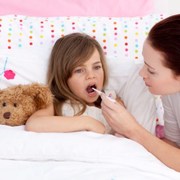 Photo: Getty Images
Photo: Getty Images
Do you know when your child is running a fever? What is the best way to take a child’s temperature to check for fever? Not sure how high the fever has to be before calling the pediatrician? As cold and flu season gets underway, now is a good time to review some thermometer basics.
A fever occurs when our bodies raise our temperature above the normal level (around 98.6 F or 37 C) to fight infection. The Mayo Clinic reminds us that not all fevers are bad and that they work to help fight infection. If your child is older than a year, sleeping through the night, playing as usual, and drinking fluids, you may decide to let the fever run its course.
If you do decide to treat a child who is uncomfortable with a fever, Mayo Clinic advises that you use acetaminophen if the child is younger than six months. Ibuprofen or acetaminophen is okay to give to children six months and up.
Remember to read packaging for proper dosing and never give aspirin to anyone, 18 years and younger, to treat for a fever.
The Mayo Clinic offers several guidelines about when to call the doctor. If your child is older than three months, call the doctor if: the temperature is 102 F/38 C and acts irritable or lethargic, or if the fever is 102 F or higher and won't respond to over-the-counter fever reducers, or lasts longer than a day. If your child is younger than three months, call the doctor if the rectal temperature registers 100.4 F/38 C or higher.
The Family Doctor website shares advice on taking a child’s temperature accurately. If you take the temperature rectally, you will get the most accurate reading. However, if a child is older than three months, a digital oral thermometer can be used.
While many of us now own digital thermometers, it is good to remember that older thermometers containing poisonous mercury are not recommended.
Before you use the thermometer, clean it using soap and lukewarm water, and rinse with cool water. After use, wash in cool, soapy water or wipe clean with rubbing alcohol.
If you take the temperature orally, remember to wait 20 minutes if your child has just had something warm or cold to eat or drink. Taking a temperature right after a bath can also give a less accurate reading. Family Doctor also advises that you don’t leave a child alone while waiting for the thermometer to register.
To take a temperature rectally, you may wish to place a young child across you're lap. Coat the bulb of the thermometer with petroleum jelly and insert it half an inch into the rectum. Hold the thermometer still and don’t let go until it beeps and registers.
To take a temperature by mouth, place the thermometer under the tongue and towards the back of the mouth. Your child should not bite down or walk with a thermometer still in his or her mouth.
Sources:
Family Doctor. Fever in Infants and Children. Web. 7 Nov. 2011.
http://familydoctor.org/familydoctor/en/diseases-conditions/fever-in-infants-and-children.html
The Mayo Clinic. Thermometer Basics. Web. 7 Nov. 2011.
http://www.mayoclinic.com/health/thermometer/HQ01481
Reviewed November 8, 2011
by Michele Blacksberg RN
Edited by Jody Smith






Add a CommentComments
There are no comments yet. Be the first one and get the conversation started!